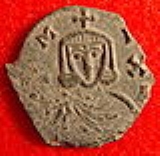
Michael I Rangabe
Encyclopedia
Michael I Rangabes (died January 11, 844) was Byzantine Emperor from 811 to 813.
Michael was the son of the patrician Theophylaktos Rangabes, the admiral of the Aegean
fleet. He married Prokopia
, the daughter of the future Emperor Nikephoros I
, and received the high court dignity
of kouropalatēs
after his father-in-law's accession in 802.
Michael survived Nikephoros' disastrous campaign against Krum of Bulgaria
, and was considered a more appropriate candidate for the throne than his severely injured brother-in-law Staurakios
. When Michael's wife Prokopia failed to persuade her brother to name Michael as his successor, Michael's supporters forced Staurakios to abdicate in his favor on October 2, 811.
Michael I attempted to carry out a policy of reconciliation, abandoning the exacting taxation instituted by Nikephoros I. While reducing imperial income, Michael generously distributed money to the army, the bureaucracy, and the Church. Elected with the support of the Orthodox
party in the Church, Michael diligently persecuted the iconoclasts
and forced the Patriarch Nikephoros to back down in his dispute with Theodore of Stoudios
, the influential abbot of the monastery of Stoudios. Michael's piety won him a very positive estimation in the work of the chronicler Theophanes the Confessor
.
In 812 Michael I reopened negotiations with the Franks
, and recognized Charlemagne
as basileus
(emperor) without saying anything else. In exchange for that recognition, Venice
was returned to the Byzantine Empire. However, under the influence of Theodore, Michael rejected the peace terms offered by Krum and provoked the capture of Mesembria (Nesebar
) by the Bulgarians. After an initial success in spring 813, Michael's army prepared for a major engagement at Versinikia
near Adrianople in June. The Byzantine army was turned to flight and the emperor's position was seriously weakened. With conspiracy in the air, Michael preempted events by abdicating in favor of the general Leo the Armenian
and becoming a monk (under the name Athanasios). His sons were castrated and relegated into monasteries, one of them, Niketas (renamed Ignatios), eventually becoming Patriarch of Constantinople
. Michael died peacefully in January 844.
 By his wife Prokopia
By his wife Prokopia
, Michael I had at least five children:
Michael was the son of the patrician Theophylaktos Rangabes, the admiral of the Aegean
Aegean Sea
The Aegean Sea[p] is an elongated embayment of the Mediterranean Sea located between the southern Balkan and Anatolian peninsulas, i.e., between the mainlands of Greece and Turkey. In the north, it is connected to the Marmara Sea and Black Sea by the Dardanelles and Bosporus...
fleet. He married Prokopia
Prokopia
Prokopia was the Empress consort of Michael I Rangabe of the Byzantine Empire.-Family:She was a daughter of Nikephoros I. The name of her mother is not known. Her only known sibling is Staurakios.-Marriage:...
, the daughter of the future Emperor Nikephoros I
Nikephoros I
Nikephoros I or Nicephorus I, Logothetes or Genikos was Byzantine emperor from 802 to 811, when he was killed in the Battle of Pliska....
, and received the high court dignity
Byzantine aristocracy and bureaucracy
The Byzantine Empire had a complex system of aristocracy and bureaucracy, which was inherited from the Roman Empire. At the apex of the pyramid stood the Emperor, sole ruler and divinely ordained, but beneath him a multitude of officials and court functionaries operated the administrative...
of kouropalatēs
Curopalates
Kouropalatēs, Latinized as curopalates or curopalata and Anglicized as curopalate, was a Byzantine court title, one of the highest from the time of Emperor Justinian I to that of the Komnenoi in the 12th century...
after his father-in-law's accession in 802.
Michael survived Nikephoros' disastrous campaign against Krum of Bulgaria
Krum of Bulgaria
Krum the Horrible was Khan of Bulgaria, from after 796, but before 803, to 814 AD. During his reign the Bulgarian territory doubled in size, spreading from the middle Danube to the Dnieper and from Odrin to the Tatra Mountains. His able and energetic rule brought law and order to Bulgaria and...
, and was considered a more appropriate candidate for the throne than his severely injured brother-in-law Staurakios
Staurakios
Staurakios or Stauracius was Byzantine emperor from July 26 to October 2, 811 in succession to his father, Nikephoros I, who had fallen at the Battle of Pliska...
. When Michael's wife Prokopia failed to persuade her brother to name Michael as his successor, Michael's supporters forced Staurakios to abdicate in his favor on October 2, 811.
Michael I attempted to carry out a policy of reconciliation, abandoning the exacting taxation instituted by Nikephoros I. While reducing imperial income, Michael generously distributed money to the army, the bureaucracy, and the Church. Elected with the support of the Orthodox
Eastern Orthodox Church
The Orthodox Church, officially called the Orthodox Catholic Church and commonly referred to as the Eastern Orthodox Church, is the second largest Christian denomination in the world, with an estimated 300 million adherents mainly in the countries of Belarus, Bulgaria, Cyprus, Georgia, Greece,...
party in the Church, Michael diligently persecuted the iconoclasts
Iconoclasm
Iconoclasm is the deliberate destruction of religious icons and other symbols or monuments, usually with religious or political motives. It is a frequent component of major political or religious changes...
and forced the Patriarch Nikephoros to back down in his dispute with Theodore of Stoudios
Theodore the Studite
Theodore the Studite was a Byzantine Greek monk and abbot of the Stoudios monastery in Constantinople. He played a major role in the revivals both of Byzantine monasticism and of classical literary genres in Byzantium...
, the influential abbot of the monastery of Stoudios. Michael's piety won him a very positive estimation in the work of the chronicler Theophanes the Confessor
Theophanes the Confessor
Saint Theophanes Confessor was a member of the Byzantine aristocracy, who became a monk and chronicler. He is venerated on March 12 in the Roman Catholic and the Eastern Orthodox Church .-Biography:Theophanes was born in Constantinople of wealthy and noble iconodule parents: Isaac,...
.
In 812 Michael I reopened negotiations with the Franks
Franks
The Franks were a confederation of Germanic tribes first attested in the third century AD as living north and east of the Lower Rhine River. From the third to fifth centuries some Franks raided Roman territory while other Franks joined the Roman troops in Gaul. Only the Salian Franks formed a...
, and recognized Charlemagne
Charlemagne
Charlemagne was King of the Franks from 768 and Emperor of the Romans from 800 to his death in 814. He expanded the Frankish kingdom into an empire that incorporated much of Western and Central Europe. During his reign, he conquered Italy and was crowned by Pope Leo III on 25 December 800...
as basileus
Basileus
Basileus is a Greek term and title that has signified various types of monarchs in history. It is perhaps best known in English as a title used by the Byzantine Emperors, but also has a longer history of use for persons of authority and sovereigns in ancient Greece, as well as for the kings of...
(emperor) without saying anything else. In exchange for that recognition, Venice
Venice
Venice is a city in northern Italy which is renowned for the beauty of its setting, its architecture and its artworks. It is the capital of the Veneto region...
was returned to the Byzantine Empire. However, under the influence of Theodore, Michael rejected the peace terms offered by Krum and provoked the capture of Mesembria (Nesebar
Nesebar
Nesebar is an ancient town and one of the major seaside resorts on the Bulgarian Black Sea Coast, located in Burgas Province. It is the administrative centre of the homonymous Nesebar Municipality...
) by the Bulgarians. After an initial success in spring 813, Michael's army prepared for a major engagement at Versinikia
Battle of Versinikia
The Battle of Versinikia was fought in 813 between the Byzantine Empire and the Bulgarian Empire, near the city of Adrianople in contemporary Turkey....
near Adrianople in June. The Byzantine army was turned to flight and the emperor's position was seriously weakened. With conspiracy in the air, Michael preempted events by abdicating in favor of the general Leo the Armenian
Leo V the Armenian
Leo V the Armenian was emperor of the Byzantine Empire from 813 to 820. A senior general, he forced his predecessor, Michael I Rangabe, to abdicate and assumed the throne. He ended the decade-long war with the Bulgars, and initiated the second period of Byzantine Iconoclasm...
and becoming a monk (under the name Athanasios). His sons were castrated and relegated into monasteries, one of them, Niketas (renamed Ignatios), eventually becoming Patriarch of Constantinople
Patriarch of Constantinople
The Ecumenical Patriarch is the Archbishop of Constantinople – New Rome – ranking as primus inter pares in the Eastern Orthodox communion, which is seen by followers as the One, Holy, Catholic, and Apostolic Church....
. Michael died peacefully in January 844.
Family

Prokopia
Prokopia was the Empress consort of Michael I Rangabe of the Byzantine Empire.-Family:She was a daughter of Nikephoros I. The name of her mother is not known. Her only known sibling is Staurakios.-Marriage:...
, Michael I had at least five children:
- Theophylaktos, co-emperor from 812 to 814.
- Staurakios
- Niketas, later Patriarch Ignatios of Constantinople.
- Georgo
- Theophano
Sources
- The Oxford Dictionary of ByzantiumOxford Dictionary of ByzantiumThe Oxford Dictionary of Byzantium is a three volume historical dictionary published by the English Oxford University Press. It contains comprehensive information in English on topics relating to the Byzantine Empire. It was edited by the late Dr. Alexander Kazhdan, and was first published in 1991...
, Oxford University Press, 1991. - Ostrogorski, G.George OstrogorskyGeorge Alexandrovič Ostrogorsky was a Russian-born Yugoslavian historian and Byzantinist who acquired worldwide reputations in Byzantine studies.-Biography:...
; History of the Byzantine State, Rutgers University Press (July 1986) - Treadgold, W. A History of the Byzantine State and Society, Stanford University Press; 1 edition (November 1, 1997)
- Gregory, T., A History of Byzantium (Blackwell History of the Ancient World), Wiley-Blackwell (March 11, 2005)

